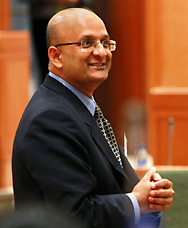What is Innovation, after all?
Experts in the field of “innovation” discuss the critical role that jazz serves in demonstrating, and training for, an innovative mind-set.

Jim Nadel, Executive Director, Stanford Jazz Festival
A term often used without a clear definition
“Innovation” is a commonly used term. In strategy documents of organizations ranging from Harvard Business School and the American Medical Association to small start-ups, the term is one that is used profusely. It is obviously important, but how you we define it and how do we achieve it?
At a recent Stanford Jazz Festival event, guests had the chance to explore the concept with leaders in business and music. Conversations revealed three essential aspects of innovation to help us start to think more deeply about what this ellusive (and often over-used) term really means.
Looking to jazz for concrete concepts
Last month, Larry Coryell & Bombay Jazz played to a capacity audience during the Stanford Jazz Festival. After the performance, some guests had the opportunity to mingle with the artists. Several of these guests, experts in the field of “innovation,” discussed the critical role that jazz serves in demonstrating, and training for, an innovative mind-set. These guests, each leaders in their respective fields, reviewed three (3) essential elements of innovation.
1. Teamwork/collaboration

Elizabeth Doty, Founder, Leadership Momentum
Elizabeth Doty, a graduate of Harvard Business School and founder of Leadership Momentum commented, “On-stage, you see the performers working in harmony to create a unified experience. They are each able to shine, but they also adapt to ensure the whole performance weaves together.” She was impressed because her work involves helping leaders collaborate more effectively. For her, teamwork is essential. She adds, “If leaders do not work as a team, their efforts to innovate can create confusion or complexity for customers and other stakeholders.”
Band member George Brooks emphasized that a great deal of emphasis of jazz is on collaboration, explaining, “We work on stepping in or holding back based on what will work best for the whole.” This type of sensitivity and awareness of group dynamics plays out in every one of their performances, as it does in other jazz performances, where there is a great deal of leeway regarding what will happen at any given point in time.
Collaboration is an important feature of the innovation process overall, according to a specialist in the field, Debra Dunn, who is also a Stanford Jazz Workshop Board member and consulting faculty member of the Stanford Design School. She, too, had been to the show, and provided background on innovation from an academic and a practical standpoint, adding that, one of the primary reasons she joined the Stanford Jazz Workshop Board was because of the method that the school uses to teach the skill of collaboration:
“The work done in the camp is about far more than music. There is a much higher probability, especially among people who have that experience during their formative years, that they will learn about how to be part of a group, how to collaborate, be open to what other people are bringing, and look on ways to build upon that. That is a big part of what happens at jazz camp: they are learning to work with others in a way is different from other educational venues.”
2. Diversity

Debra Dunn, Consulting Faculty Member, Stanford Design School
To Dunn, this particular performance also demonstrated another vital part of the innovation process: bringing diverse points of view together “to create the germ of some phenomenal new break-through.” The band had members from America and India performing onstage together. After describing the successful aesthetic effect that that created musically, she went on to explain how the concept is successful in business:
“The concert on Saturday night was a beautiful example of how jazz exhibits and models innovation. That group brought together radically different musical forms – classical Indian music and what we think of more commonly as jazz. When you take a multi dimensional team trying to solve a problem and you put them in a room together, it looks very much like that. This concert provided a great example [of this element of the innovation process.]” Describing it in business terms, she believes that bringing outside perspectives into an organization helps that organization create and implement important changes.”
3. Improvisation – working without a script

George Brooks (upper left) of Larry Coryell & Bombay Jazz
According to Jim Nadel, Founder and Artistic & Executive Director of Stanford Jazz Workshop, “An important part of the innovative process involves risk-taking and trying new things. Performers and students, both, develop the skills needed to experiment and improvise. These skills include: self-confidence, goal-setting, and spontaneity” says Nadel. He explains that students learn to make quick decisions, but also to prepare/practice, so that, when the moment comes, they are “ready” to react with strong skills to bring a solid result. “Having a beginners mind outlook, combined with years of practice, enable those who improvise to do so successfully,” says Nadel.
Looking forward to hearing more up-to-the-minute information on how those around us are defining the term “innovation.”












